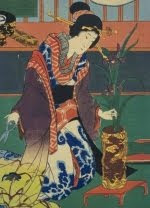In 1913 Mary Averill, American born 1866, published her first book on ikebana, Japanese Flower Arrangement Applied to Western Needs. She wanted to share what she had learned in Japan, and she wanted to find out if there where others who where interested in understanding the philosophy inherited in the old art of flower arranging. In 1915 her second book, Flower Art of Japan, was released. Both have since then been reprinted several times and can be bought second hand and as replicas of old editions.
 |
| Ginkaku-ji, Kyoto, photo: Wikipedia |
 |
| Shogun Ashikaga Yoshimasa |
When Mary Averill wrote her books, Koshin Ryu was no longer taught at Ginkaku-ji, and there was only one teacher left from this school in Kyoto. I have found no records of any Koshin Ryu ikebana school so it probably doesn't exist anymore.
Mary Averill writes in Flower Art of Japan that she is proud of having studied with Koshin Ryu because of the connection to Yoshimasa and Ginkaku-ji. Let's follow her for a trip down memory lane:
Mary Averill
Japanese Flower Arrangement [ike-bana] Applied to Western Needs 1913
Mary Averill writes in Flower Art of Japan that she is proud of having studied with Koshin Ryu because of the connection to Yoshimasa and Ginkaku-ji. Let's follow her for a trip down memory lane:
"Yoshimasa built Ginkaku-ji as a place of retirement after abdicating the throne, accompanied there by his two favorites, Soami and Shuko, and by this famous trio Flower Arrangement and the Tea Ceremony were raised to the rank of fine arts. It was my great privilege to visit this temple last summer with the Ko-Shin-Ryu Master before mentioned, and sit with him inside the enclosure which holds Yoshimasa's image, while he made a very beautiful flower arrangement, which was left as an offering in front of this simple wooden figure."Books:
Mary Averill
Japanese Flower Arrangement [ike-bana] Applied to Western Needs 1913
Flower Art of Japan: With 129 Illustrations 1915
Flower Art of Japan can also be red online without illustrations on this link.
Flower Art of Japan can also be red online without illustrations on this link.












No comments:
Post a Comment